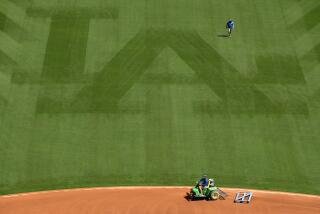How Dry Itâs Not: Baseball Is Ready for Alcohol Rehab
A half-dozen or so for the road was all Lenny Dykstra had before he climbed into his car and wrapped it around a tree.
âHey, Joey! Keg party at my house after the game!â were the words that sent Albert (nee Joey) Belle into a baseball-flinging, spectator-pinging rage.
Plastic beer cups runneth over in the ballparks of America, arming the fans for the kind of border skirmishes that gave the 11 oâclock news its Jose Canseco-being-restrained-at-Yankee-Stadium video bite.
Major league baseball looks and listens and somberly shakes its head.
The situation has gotten so bad, it says, itâs enough to drive a man to drink.
Baseball canât be too careful whenever it mounts its high horse to confront the evils of alcohol. You know what they say: Donât drink and drive. Itâs much too easy to get thrown when one of your teams plays in Busch Stadium, another is called the Brewers and all of them rake in major advertising dollars from the breweries, wineries and distilleries that fuel another national pastime.
Baseball is not alone, of course. All professional sports have wrestled to come to grips with the medical assertion that alcohol is a drug.
A drug? Say the magic word, and the red lights flare, and the sirens sound. Sports have memorized the proper response at the drop of a name. The knee-jerk is finely honed.
Marijuana, bad.
Cocaine, worse.
Steroids, give us back the gold medal.
And just in case anybody forgets, bumper stickers have been printed up. Just Say No.
Alcohol, however, is different. Sports canât say no. The hand has fed them for so long, theyâre too buzzed to bite back.
Everybody knows that old jocks never die. They get Lite Beer commercials. Everybody knows what happens on Super Sunday. They play the Bud Bowl. Check out the billboards inside the stadiums and the arenas, the ads in the programs, the radio timeouts for a word from their sponsor. So, what is it? Less filling or great tasting?
Alcohol has one advantage over the other drugs. Itâs legal. Good thing for that. Legalize more of them, and before long, the Detroit Bongs would be hosting the Milwaukee Freebasers. Head shop located to the right of the soft-serve stand.
The concept of athlete-as-role-model gets worked over every time a Dykstra fails to walk a straight line, but thatâs really a minor part of the picture. Truth is, athletes never were great role models, a tradition that dates back to Babe Ruth, who called his shots as ably at the bar as he did at the plate. Players transgressed just as much back then; they just transgressed without the scrutiny of ESPN, CNN, USA, SportsChannel and sportswriters who chose loyalty to their newspaper over loyalty to the team.
Role-modeling begins at the top, with the officials who govern and the owners who employ the athletes. The message they deliver is mixed, at best: Donât drink to excess, but please patronize our sponsors, our good friends at Budweiser, Miller, Michelob and Seagramâs.
A similar conflict vexed the womenâs professional tennis tour for years. How could a sport that promotes health and athleticism justify its being bankrolled by a cigarette company?
Notice today that the womenâs tour is sponsored by Kraft Foods and not Virginia Slims.
Baseball and football try to justify the partnership with alcohol by asking whatâs wrong with a beer between innings or a wine cooler in front of the big screen on Monday night. Weâre selling moderation, not obliteration, and besides, weâre not the only ones in the entertainment business plugging the stuff. They do sell beer at rock concerts.
Yes, they do, but assault isnât full-on and frontal, with hops and barley in the lifeblood. The name of the band is the Rolling Stones, not the Rolling Rocks. In rock ânâ roll, to sign on with a beer company is to sell out. In baseball, itâs the recommended way to pay the bills.
And what of the athlete who abuses alcohol? All four major sports leagues have a âdrug policy,â but none has an alcohol policy. The responsibility is delegated to the teams, which have tended to flail away through trial and error.
The Angels used to provide liquor in the clubhouse and on team flights before John Candelaria was hit twice in a month for driving while intoxicated, once after a flight home.
The clubâs reaction was an overreaction: No more beer on planes or in the clubhouse. The players balked, their protest headed, interestingly, by a non-drinker named Wally Joyner, and eventually beer was restored to the Angel clubhouse--on the stipulation that no beer could leave the clubhouse.
Whateverâs said here and poured here, let it stay here.
Some teams, too, have targeted the fans in the stands--limiting beer sales to two per customer or cutting them off after a certain inning. What they canât control is what happens once the fans and the players go home.
There, culture takes control. Whatâs accepted, whatâs not. Whatâs desirable, whatâs not. Whatâs good for Bob Uecker and John Madden, whatâs not.
The young viewers of the Lite Beer commercials of today are the drunken hecklers and the Lenny Dykstras of tomorrow.
More to Read
Go beyond the scoreboard
Get the latest on L.A.'s teams in the daily Sports Report newsletter.
You may occasionally receive promotional content from the Los Angeles Times.










